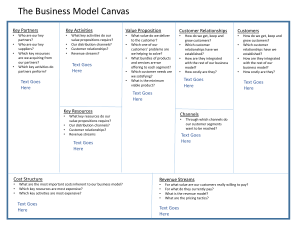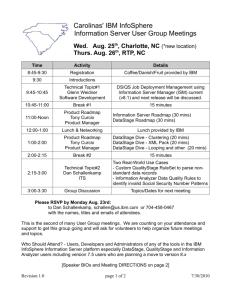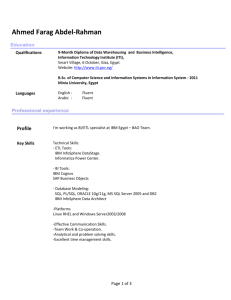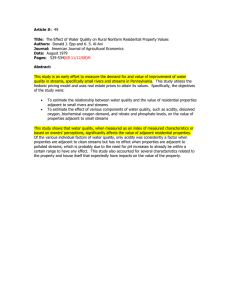– DataStage Streams Integration Mike Koranda
advertisement
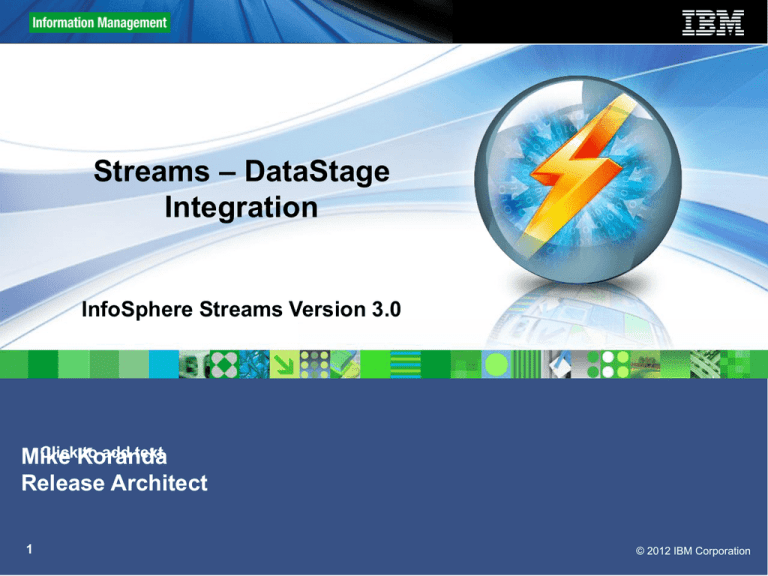
Streams – DataStage
Integration
InfoSphere Streams Version 3.0
ClickKoranda
to add text
Mike
Release Architect
1
© 2012 IBM Corporation
Agenda
What is InfoSphere Information Server and DataStage?
Integration use cases
Architecture of the integration solution
Tooling
2
© 2012 IBM Corporation
Information Integration Vision
Transform Enterprise Business
Processes & Applications with
Trusted Information
Deliver Trusted Information
for Data Warehousing and
Business Analytics
Build and
Manage a
Single View
Secure Enterprise
Data & Ensure
Compliance
Address
information
integration in
context of
broad and
changing
environment
Simplify &
accelerate:
Design once
and leverage
anywhere
Integrate &
Govern Big
Data
Consolidate and
Retire
Applications
Make Enterprise Applications
more Efficient
3
© 2012 IBM Corporation
IBM Comprehensive Vision
Traditional Approach
New Approach
Structured, analytical, logical
Creative, holistic thought, intuition
Data
Data
Warehouse
Warehouse
Hadoop
Hadoop
Streams
Streams
Transaction Data
Internal App Data
Mainframe Data
Web Logs
Structured
Repeatable
Linear
Information
Integration &
Governance
Unstructured
Exploratory
Iterative
4
Text & Images
Sensor Data
OLTP System Data
ERP data
Social Data
Traditional
Traditional
Sources
Sources
New
New
Sources
Sources
RFID
© 2012 IBM Corporation
IBM InfoSphere DataStage
Industry Leading Data Integration
for the Enterprise
Simple to design - Powerful to deploy
Rich capabilities spanning six critical dimensions
Developer Productivity
Rich user interface features that
simplify the design process and
metadata management requirements
Transformation Components
Extensive set of pre-built objects that
act on data to satisfy both simple &
complex data integration tasks
Connectivity Objects
Native access to common industry
databases and applications exploiting
key features of each
5
Runtime Scalability & Flexibility
Performant engine providing unlimited
scalability through all objects tasks in
both batch and real-time
Operational Management
Simple management of the operational
environment lending analytics for
understanding and investigation.
Enterprise Class Administration
Intuitive and robust features for
installation, maintenance, and
configuration
© 2012 IBM Corporation
Use Cases - Parallel real-time analytics
6
© 2012 IBM Corporation
Use Cases - Streams feeding DataStage
7
© 2012 IBM Corporation
Use Cases – Data Enrichment
8
© 2012 IBM Corporation
Runtime Integration High Level View
Streams
DataStage
Job
Job
Streams
Connector
TCP/IP
DSSource /
DSSink
Operator
Composite operators that wrap existing
TCPSource/TCPSink operators
9
© 2012 IBM Corporation
Streams Application (SPL)
use com.ibm.streams.etl.datastage.adapters::*;
composite SendStrings {
type RecordSchema =
rstring a, ustring b;
graph
stream<RecordSchema> Data = Beacon() {
param iterations : 100u;
initDelay:1.0;
output Data : a="This is single byte chars"r,
b="This is unicode"u;
}
() as Sink = DSSink(Data) {
param name : "SendStrings";
}
config
applicationScope : "MyDataStage";
}
10
• When the job starts, the DSSink/DSStage stage
registers its name with the SWS nameserver
© 2012 IBM Corporation
DataStage Job
User adds a Streams Connector and configures properties and columns
11
© 2012 IBM Corporation
DataStage Streams Runtime Connector
Uses nameserver lookup to establish connection (“name” + “application
scope”) via HTTPS/REST
Uses TCPSource/TCPSink binary format
Has initial handshaking to verify the metadata
Supports runtime column propagation
Connection retry (both initial & in process)
Supports all Streams types
Collection types (List, Set, Map) are represented as a single XML column
Nested tuples are flattened
Schema reconciliation options (unmatched columns, RCP, etc)
Wave to punctuation mapping on input and output
Null value mapping
12
© 2012 IBM Corporation
Tooling Scenarios
User creates both DataStage job and Streams application from scratch
– Create DataStage job in IBM Infosphere DataStage and QualityStage
Designer
– Create Streams Application in Streams Studio
User wishes to add Streams analysis to existing DataStage jobs
– From Streams Studio create Streams application from DataStage
Metadata
User wishes to add DataStage processing to existing Streams application
– From Streams Studio create Endpoint Definition File and import into
DataStage
13
© 2012 IBM Corporation
Streams to DataStage Import
1.
2.
3.
4.
On Streams side, user runs ‘generate-ds-endpoint-defs’ command to generate an ‘Endpoint Definition
File’ (EDF) from one or more ADL files
User transfers file to DataStage domain or client machine
User runs new Streams importer in IMAM to import EDF to StreamsEndPoint model
Job Designer selects end point metadata from stage. The connection name and columns are populated
accordingly.
ADL
ADL
Streams
command
line or
Studio
menu
EDF
EDF
IMAM
Xmeta
FTP
14
© 2012 IBM Corporation
Stage Editor
15
© 2012 IBM Corporation
Stage Editor
16
© 2012 IBM Corporation
DataStage to Streams Import
1.
2.
3.
4.
On Streams side, user runs ‘generate-ds-spl-code’ command to generate a template application that
from a DataStage job definition
The command uses a Java API that uses REST to query DataStage jobs in the repository
The tool provides commands to identify jobs that use the Streams Connector, and to extract the
connection name and column information
The template job includes a DSSink or DSSource stage with tuples defined according to the DataStage
link definition
Xmeta
17
REST API
HTTP
Java
API
Streams
command
line or
Studio
menu
SPL
© 2012 IBM Corporation
DataStage to Streams Import
18
© 2012 IBM Corporation
Availability
Streams Connector available in InfoSphere Information Server 9.1
The Streams components available in InfoSphere Streams Version
3.0 in the IBM InfoSphere DataStage Integration Toolkit
19
© 2012 IBM Corporation
